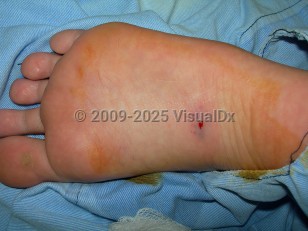Weeverfish spine puncture
Alerts and Notices
Important News & Links
Synopsis

Weeverfish (Echiichthys, formerly belonging to the genus Trachinus) are fish found in Atlantic and Mediterranean waters as well as the English Channel, Black Sea, North Sea, and along the northern coast of Africa. They can grow up to 53 cm (21 in) long and are typically found in shallow waters, buried in the sand with only their eyes visible. Weeverfish are the most common venomous fish living in temperate waters and the most venomous fish in Europe. They are capable of causing extremely painful wounds in humans.
There are 4 species that live half buried and are, thus, almost invisible to bathers: E. vipera, E. aranus, E. radiatus, and E. lineatus. Most accidents occur when the hidden fish are accidentally stepped on by a bather or when a fisherman accidentally captures a weeverfish. Occasionally, a weeverfish may aggressively strike a person without warning with one of its spines.
All species have a venom apparatus consisting of spines covered by glandular epithelium: 4-8 dorsal spines and 1 spine near each gill (opercular), all venomous. During envenomation, the sheath is pushed down the spine, causing compression of the venom glands located at the base of the spines. Venom then travels through grooves in the spines and into the wound.
Injury from a weeverfish spine is instantaneously extremely painful and rapidly involves the whole affected extremity. The burning or crushing pain usually peaks in 30 minutes and lasts for 24 hours. The wounded patient typically presents with severe pain, edema and erythema, nausea, vomiting, and joint pain. Other local symptoms may include itching, warmth, pallor, or ecchymosis. There have been reports of seizures, cardiac arrhythmias, paralysis, hypotension, and even deaths, although these are probably associated with bacterial infections and sepsis.
Weeverfish venom is heat labile and is neurotoxic and hemotoxic. As in all venomous fish injuries, immersion of the affected area in hot, nonscalding water for 30-90 minutes can help alleviate pain.
There are 4 species that live half buried and are, thus, almost invisible to bathers: E. vipera, E. aranus, E. radiatus, and E. lineatus. Most accidents occur when the hidden fish are accidentally stepped on by a bather or when a fisherman accidentally captures a weeverfish. Occasionally, a weeverfish may aggressively strike a person without warning with one of its spines.
All species have a venom apparatus consisting of spines covered by glandular epithelium: 4-8 dorsal spines and 1 spine near each gill (opercular), all venomous. During envenomation, the sheath is pushed down the spine, causing compression of the venom glands located at the base of the spines. Venom then travels through grooves in the spines and into the wound.
Injury from a weeverfish spine is instantaneously extremely painful and rapidly involves the whole affected extremity. The burning or crushing pain usually peaks in 30 minutes and lasts for 24 hours. The wounded patient typically presents with severe pain, edema and erythema, nausea, vomiting, and joint pain. Other local symptoms may include itching, warmth, pallor, or ecchymosis. There have been reports of seizures, cardiac arrhythmias, paralysis, hypotension, and even deaths, although these are probably associated with bacterial infections and sepsis.
Weeverfish venom is heat labile and is neurotoxic and hemotoxic. As in all venomous fish injuries, immersion of the affected area in hot, nonscalding water for 30-90 minutes can help alleviate pain.
Codes
ICD10CM:
T63.591A – Toxic effect of contact with other venomous fish, accidental, initial encounter
SNOMEDCT:
241823005 – Poisoning from weever fish spine
T63.591A – Toxic effect of contact with other venomous fish, accidental, initial encounter
SNOMEDCT:
241823005 – Poisoning from weever fish spine
Look For
Subscription Required
Diagnostic Pearls
Subscription Required
Differential Diagnosis & Pitfalls

To perform a comparison, select diagnoses from the classic differential
Subscription Required
Best Tests
Subscription Required
Management Pearls
Subscription Required
Therapy
Subscription Required
References
Subscription Required
Last Updated:10/19/2017
Weeverfish spine puncture

